A potentially severe vulnerability (CVE-2022-41558) has been discovered in the Visualizations component of TIBCO Software Inc.'s TIBCO Spotfire Analyst, TIBCO Spotfire Analytics Platform for AWS Marketplace, TIBCO Spotfire Desktop, and TIBCO Spotfire Server. This vulnerability allows a low privileged attacker with network access to execute stored Cross-Site Scripting (XSS) attacks on the affected system.
The affected releases are as follows
- TIBCO Spotfire Analyst: versions 11.4.4 and below, 11.5., 11.6., 11.7., 11.8., 12.., 12..1, and 12.1.
TIBCO Spotfire Analytics Platform for AWS Marketplace: versions 12.1. and below
- TIBCO Spotfire Desktop: versions 11.4.4 and below, 11.5., 11.6., 11.7., 11.8., 12.., 12..1, and 12.1.
- TIBCO Spotfire Server: versions 11.4.8 and below, 11.5., 11.6., 11.6.1, 11.6.2, 11.6.3, 11.7., 11.8., 11.8.1, 12.., 12..1, and 12.1.
Exploit Details
This vulnerability is exploitable through stored Cross-Site Scripting (XSS) attacks, which involve an attacker injecting malicious scripts into a vulnerable web application. When a victim visits the infected page, the malicious code is executed in their browser, potentially allowing the attacker to steal sensitive data, hijack sessions, or perform other malicious actions.
The vulnerability exists due to insufficient validation and output encoding of user-supplied values within the Spotfire Visualization component. As a result, an attacker can inject malicious JavaScript code into the component, which is then stored and executed when a victim views the infected visualization.
A significant factor in this vulnerability is that a successful attack requires human interaction from a person other than the attacker, such as an unsuspecting user clicking on a malicious link or interacting with the infected visualization.
Proof Of Concept
Here's an example of a code snippet that demonstrates how an attacker might exploit the vulnerability:
// Malicious JavaScript code
<script>alert("XSS Attack!");</script>
When this code is injected into a vulnerable visualization, any user who interacts with the affected visualization will see an alert with the message "XSS Attack!". This basic example demonstrates how an attacker could execute a stored XSS attack on a victim's system.
For more information on this vulnerability, you can refer to the following sources
1. Official CVE Record: https://cve.mitre.org/cgi-bin/cvename.cgi?name=CVE-2022-41558
2. TIBCO Security Advisory: https://www.tibco.com/services/support/advisories/Security [Replace with the actual advisory URL if available]
Mitigation and Remediation
At the time of writing, TIBCO has not released any patches to fix this vulnerability. It is advisable for users of affected TIBCO Spotfire products to regularly check the official TIBCO Security Advisories page for updates and instructions on how to mitigate the risks associated with this vulnerability.
As a temporary measure, users should exercise caution when viewing unfamiliar visualizations, clicking on unknown links, or interacting with untrusted resources in the affected environment. Consider implementing additional security controls, such as Content Security Policy (CSP) and strict input validation, to minimize the risk of successful XSS attacks.
Conclusion
CVE-2022-41558 is a critical stored Cross-Site Scripting vulnerability affecting TIBCO Spotfire Analyst, TIBCO Spotfire Analytics Platform for AWS Marketplace, TIBCO Spotfire Desktop, and TIBCO Spotfire Server. Users of the affected products should stay informed on the latest updates and apply appropriate mitigations to reduce their exposure to this threat.
Timeline
Published on: 11/15/2022 19:15:00 UTC
Last modified on: 11/18/2022 21:29:00 UTC
